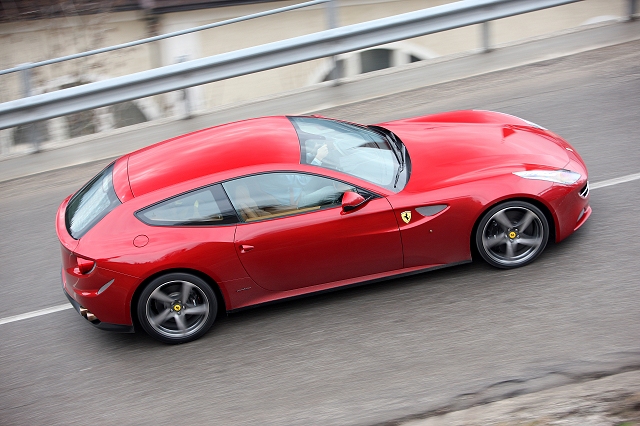The 612 Scaglietti was a fine car - so long as you didn't have to look at it. And while its replacement, the Ferrari FF, still has challenging looks and four seats, it spearheads a new direction for the company with its revolutionary transmission. Crucially, it still drives as a Prancing Horse should.
In the metal 4/5
While the 612 Scaglietti was pig ugly, the new Ferrari FF might be best described as challenging. The gaping front grille definitely benefits by having its fins painted black but apart from that the nose is very reminiscent of the 458 Italia's. The rear, however, with its steeply-raked hatch, reminds us of BMW's mad Z3 M Coupe. It's an acquired taste, alright, but it's definitely distinctive.
Even if the exterior looks don't do it for you, you'll find nothing at all to complain about inside the Ferrari FF's glorious cabin. Practically every surface is covered in beautiful, supple leathers and the instrumentation is intelligently and tastefully laid out. Only the carbon fibre steering wheel threatens the Learjet vibe, but you could always specify a different one. The seats are generous, both front and rear, and there's easily enough room for two, normally-limbed adults to ride in the back, while the boot offers 450 litres of luggage space (800 if you fold down the split rear seats).
Driving it 5/5
Any car with 650 furious horses under its bonnet needs to be reigned in with clever computer technology if it's to remain drivable in normal road conditions. And the Ferrari FF is more clever than most. It has a new four-wheel drive system that Ferrari is calling '4RM' and, like conventional set-ups, it transfers torque to each corner. However, it's half the weight of a regular system and, more importantly, the power transfer unit (PTU) for the front wheels is connected directly to the engine.
It's all very complex and clever but the upshot is that there's no mechanical connection between the front and rear axles. Which means it can be rear-wheel drive in normal use, even when you're pressing on. The front only gets power when the various sensors detect a serious loss of grip. For the rest of the time the FF feels exactly as a V12 Ferrari should. And that means it's a truly epic driver's car.
The engine is truly a masterpiece and Ferrari hasn't strangled its soundtrack. On the contrary, it can always be heard, even at cruising speeds. But it's never an unwelcome guest - how could that magnificent noise ever be viewed as an annoyance? We tested the FF in the Dolomite region of northern Italy and that meant lots of tunnels. Tunnels and V12 engines are the best possible combination and the process is very straightforward. Lower the windows, slow down, drop into second gear, stamp on the loud pedal and hold on for dear life while grinning like the village idiot. It would have been rude not to.
It may be a more practical Ferrari but the FF can still keep up with a 599 GTB Fiorano. It'll crack 100km/h in 3.7 seconds and won't run out of puff until it's doing 335km/h. So its performance credentials are beyond question. It does feel like the power is being sent to the rear wheels, but there's something strange going on: there's a feeling of security added to the mix. Approach a corner at an inappropriately high speed, turn in and the front wheels simply grip and bring you round with scalpel-sharp precision. Extraordinary.
The Ferrari FF shrinks around its driver; it's an absolute blast. The F1 gearbox sets new standards in shift times and the carbon brakes and magnetic damping allow this huge car to remain utterly composed in all conditions. We hate to say it but the FF is practically flawless on the road.
What you get for your money 4/5
It's difficult to think of a direct competitor for the Ferrari FF. Price-wise you could plump for a Bentley Mulsanne or a nicely-specced Rolls-Royce Ghost but dynamically those two cars are totally different. Aston's gracious Rapide offers a genuine sportscar experience, looks stunning, has four doors and a V12 engine for a lot less, while a Porsche Panamera Turbo boasts even better value if you can bear the looks of the thing. Regardless of the high price, Ferrari FF owners still need to pay extra for parking sensors and a rear wiper, which seems a bit much.
Worth Noting
One innovation Ferrari seems proud of is an optional, small LCD screen on the passenger side of the dashboard. The company, embarrassingly, refers to it as the "front emotion display screen" and what it does is relay information regarding your speed, what gear you're in, how hard you're revving, individual wheel traction and the like. Bound to be the cause of much domestic disharmony, we'd suggest you avoid it.
Summary
It's obscenely expensive, the Ferrari FF, but that will ensure exclusivity, which is priceless at this end of the market. It's packed to the gunnels with groundbreaking technology, is supremely well engineered and is a genuinely exciting and desirable supercar. This car proves beyond doubt that a proper Ferrari doesn't need to be mid-engined with two seats. The FF is a proper Ferrari.






























